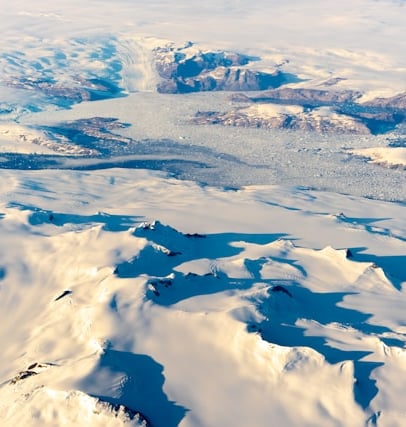Why Trump Wanted Greenland: Unpacking the Geopolitical, Economic, Strategic Motivations, and Political Challenges
In 2019, U.S. President Donald Trump proposed purchasing Greenland, an autonomous territory of Denmark, driven by strategic, economic, and geopolitical motivations. Greenland’s location in the Arctic, rich natural resources, and proximity to key U.S. military bases made it a valuable asset for monitoring Russia and enhancing American influence in the region. Trump’s proposal was rejected by both Denmark and Greenland, citing sovereignty and autonomy concerns. The idea also stirred geopolitical tensions with Russia, China, and NATO allies. Despite facing significant diplomatic, legal, and environmental challenges, the proposal highlighted the growing importance of the Arctic in global geopolitics. Ultimately, it was an attempt to secure U.S. dominance in a rapidly changing global landscape.
GEO-POLITICS


In August 2019, the world was taken aback when U.S. President Donald Trump expressed an interest in purchasing Greenland, an autonomous territory of Denmark. The idea seemed to many like a whimsical proposal or a geopolitical stunt. However, as with many of Trump’s moves, there were deeper motivations at play. To understand why Trump wanted Greenland, it is necessary to unpack the geopolitical, economic, strategic, and political factors behind his interest, as well as the challenges he faced in pushing forward such an unconventional idea.
The Historical Context
Greenland, the world’s largest island, has a long history of strategic importance. Its location in the North Atlantic, situated between North America and Europe, has made it a critical site for military, economic, and geopolitical interests. Denmark has held sovereignty over Greenland since 1721, although the island became an autonomous territory within the Kingdom of Denmark in 1979, with control over its domestic affairs while Denmark remains responsible for foreign policy and defense.
During the Cold War, Greenland's significance was underscored by the establishment of Thule Air Base, a critical U.S. military base in Greenland. This base, operational since the 1950s, continues to serve as a vital asset for the U.S. in monitoring Russia's activities in the Arctic and safeguarding the U.S. from potential missile threats. Greenland has remained of particular interest in the post-Cold War era, as geopolitical and environmental shifts in the Arctic region make it a highly sought-after territory.
Geopolitical Motivations: A Changing World Order
Trump’s interest in Greenland was intricately tied to the evolving geopolitical landscape, particularly the increasing competition in the Arctic. As global warming accelerates, the Arctic ice sheet is melting, opening up new shipping routes and revealing vast natural resources that were previously inaccessible. This shift has attracted attention from countries like the U.S., Russia, China, and Canada, all vying for influence in the region.
Greenland’s strategic location offers control over key Arctic shipping lanes and provides proximity to Russia’s northern coastline. For the U.S., acquiring Greenland would have enhanced its strategic position in the Arctic, allowing the U.S. to monitor Russian military activities and control access to vital shipping routes.
Moreover, Greenland's location is also near several other U.S. military bases, such as those in Alaska and Canada, amplifying the island's importance as part of North American defense infrastructure. Trump's desire to control this geographic and military advantage likely stemmed from a broader goal of preserving U.S. dominance over the Arctic, an area of increasing importance to global security and commerce.
Economic Motivations: Access to Natural Resources
Greenland is rich in natural resources, making it highly valuable from an economic perspective. The island is known to have significant deposits of rare-earth minerals like lithium, graphite, and uranium, which are essential for industries such as technology, renewable energy, and defense. Additionally, there is considerable potential for oil and gas exploration offshore, though development has been slow due to environmental concerns and the island’s delicate ecosystem.
The global demand for rare-earth minerals has surged, driven by the growth of clean energy technologies and electric vehicles. Greenland’s untapped reserves could offer the U.S. the opportunity to secure a critical supply of these resources, reducing dependence on China, which controls a large portion of the global rare-earth market. By acquiring Greenland, the U.S. would not only gain access to these valuable resources but could also control them as part of its broader economic strategy.
Furthermore, Greenland’s location in the Arctic makes it a potential hub for future shipping routes. The opening of the Northwest Passage, due to the retreat of polar ice, could create new maritime trade routes, potentially reducing shipping times between Asia and Europe by up to 40%. This would result in significant economic benefits from controlling Greenland, as it could facilitate trade and enhance U.S. access to global markets.
Strategic Influence on Other Nations: A Power Play
Trump’s interest in Greenland also had significant strategic implications for his relations with other countries, particularly those with stakes in the Arctic region. The potential acquisition of Greenland would have shifted the balance of power, not just in the Arctic, but also in global diplomacy.
Denmark and the EU: Greenland’s connection to Denmark meant that the U.S. would have needed Denmark’s approval to purchase the island, something that was never going to happen. Denmark’s Prime Minister, Mette Frederiksen, rejected the offer as “absurd,” and Greenland’s leadership echoed the sentiment, reaffirming the island’s commitment to self-governance and rejecting any notion of sale. This rejection was a clear indication of Denmark’s resistance to U.S. interference in its autonomous territory, highlighting the complexities of sovereignty and international diplomacy.
Russia: Russia, which has a significant military presence in the Arctic, viewed Greenland’s strategic position as a potential threat. Moscow has been expanding its military infrastructure in the region in recent years, asserting control over Arctic territories and resources. The U.S. attempt to acquire Greenland would have been perceived by Russia as a direct challenge to its ambitions in the Arctic. With proximity to Russian territory and vital shipping routes, Greenland would provide the U.S. with an upper hand in the region, and Russia would undoubtedly respond with diplomatic and military measures to counterbalance any U.S. presence.
China: China has also been expanding its influence in the Arctic. Beijing’s "Polar Silk Road" initiative aims to establish trade routes through the Arctic, facilitating access to new shipping lanes and resources. Greenland’s vast mineral wealth has attracted Chinese investment, with several Chinese companies already eyeing mining operations on the island. Trump's push to purchase Greenland may have been partially motivated by a desire to block Chinese influence in the region and ensure that the U.S. maintained control over Greenland’s resources and strategic location.
NATO: Greenland’s role in NATO’s defense strategy is another important consideration. As a member of NATO, Denmark, and by extension, Greenland, plays a key role in the alliance’s defense posture in the North Atlantic. The U.S. acquisition of Greenland would have further cemented its position as the leading military power within NATO, ensuring that the U.S. could influence NATO’s Arctic strategy and maintain its dominance in the region.
Political Motivations: A Domestic and Global Power Play
While the geopolitical and economic motivations were clear, Trump’s desire to acquire Greenland was also politically driven. Trump often used bold, unconventional moves to appeal to his base and reinforce his "America First" agenda, which emphasized national sovereignty, economic independence, and assertive foreign policy. The proposal to acquire Greenland could have been viewed as part of this broader strategy.
Appealing to Trump's Base: Trump’s supporters often viewed his actions as a reaffirmation of U.S. strength on the world stage. By pursuing the acquisition of Greenland, Trump was tapping into a nationalist sentiment, demonstrating that the U.S. would not hesitate to assert control over valuable territories and resources.
Shifting Arctic Power Dynamics: The Arctic is becoming an increasingly contested region, with Russia, China, and the U.S. all vying for influence. Trump's proposal to acquire Greenland signaled that the U.S. would be active in securing its interests in the region, particularly in response to Russian and Chinese ambitions. Greenland, with its vast resources and strategic location, represented an opportunity to gain an upper hand in the Arctic’s geopolitical struggle.
Worsening U.S.-European Relations: Trump’s relationship with Europe was often strained, and the Greenland acquisition proposal was another example of the transactional approach he took to international diplomacy. By pushing for Greenland, Trump may have been testing the boundaries of U.S.-European relations, signaling that the U.S. would act unilaterally in its national interest, even at the expense of longstanding alliances.
Negotiation Tactics: Trump was known for his unconventional approach to negotiations, often making bold and seemingly outlandish proposals to gain leverage. His offer to purchase Greenland could have been part of a broader strategy to engage in tougher negotiations with Denmark, Greenland, or even other Arctic nations over matters related to defense, trade, and resource extraction.
Challenges to Acquiring Greenland
Despite these motivations, Trump’s proposal faced significant challenges:
Sovereignty and International Law: Greenland’s status as an autonomous territory within Denmark complicated any attempt to acquire it. Denmark holds sovereignty over Greenland's foreign policy, and any transaction would require the approval of both the Danish and Greenlandic governments. This made the idea of acquiring Greenland politically and legally infeasible.
Danish and Greenlandic Rejection: Denmark and Greenland quickly rejected the idea, with Denmark’s Prime Minister calling it “absurd.” Greenland’s leaders emphasized their desire for greater autonomy, and the proposal was seen as a violation of their sovereignty.
Geopolitical Backlash: Trump’s push to acquire Greenland risked straining relations with key allies, including Denmark and NATO, while provoking Russia and China. The idea was seen as an attempt to undermine international norms and redraw territorial boundaries.
Environmental Concerns: Greenland’s delicate ecosystem, which is experiencing rapid environmental changes due to climate change, also presented a challenge. Any move to exploit the island’s resources would be met with significant opposition from environmental groups and could further exacerbate Greenland’s environmental vulnerabilities.
Conclusion: A Complex Geopolitical Puzzle
Trump’s desire to acquire Greenland was not a mere whimsical proposal, but rather a strategic move motivated by geopolitical, economic, and political factors. Greenland’s location, military significance, and vast natural resources made it an attractive target for U.S. interests. However, the proposal was met with significant resistance from Denmark, Greenland, and the international community, making its realization highly improbable. The incident highlighted the complexities of global diplomacy, territorial sovereignty, and the increasingly important role the Arctic plays in global power dynamics.
In the end, while Trump’s attempt to acquire Greenland may have been politically driven, it also underscored the growing competition in the Arctic, which will continue to shape geopolitics for years to come. Even though the acquisition itself was not achieved, the motivations behind it remain an important reflection of the U.S. strategy in a changing global order.


